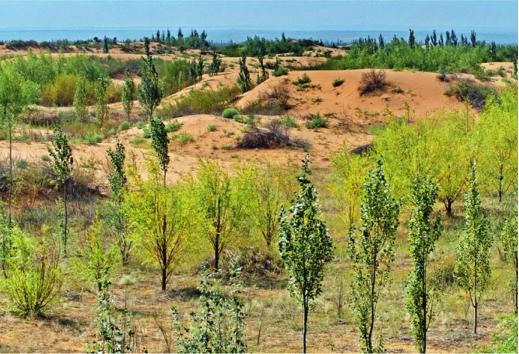Steady Progress in Controlling Desertification
Steady Progress in Controlling Desertification
According to the National Forestry and Grassland Administration, during the past five years China has successfully carried out desertification mitigation programs in more than 10 million hectares and addressed the challenge of stony desertification extending over 1.3 million hectares. The project tackled the source of sand storms in Beijing and Tianjin, for example, and planted more than one million hectares of forests, fixing sands over 34,700 hectares.
Over the past five years China has established 46 reserves in desertified areas that add up to 1.77 million hectares, 50 desert parks that cover 430,000 hectares in total, and 53 desertification control demonstration zones. The central budget earmarked RMB 10 billion to stop and reverse stony desertification. As a result, the areas of stony desertification in China have fallen to 10.07 million hectares, a reduction of 1.93 million hectares from 2011; the silt volume in the Yangtze River has dropped by at least 40 percent; and vegetation coverage in stony desertification areas has risen to 61.4 percent.
Each of these advancements has not only improved the eco-environment but also boosted economic development. Anti-desertification programs go hand in hand with green operations, such as the planting of herbs and fruit trees, all of which improves the economic structure of concerned regions and raises the income of local people.
Radio and TV School Helps Generate Expert Farmers
Last year marked the 40th anniversary of the founding of Central Agricultural Radio and TV School. Over the past years, the school has broadcasted 30,000 hours of radio and TV programs on agriculture and provided technology training for 400 million farmers. Nearly six million farmers have graduated from the school with diplomas at the vocational school level and above, and more than 30 million received systematic education. The school has made significant contributions to the development of Chinas agriculture and rural areas. During the COVID-19 pandemic alone, it provided cloud technical training to 20 million people.
China Has the Worlds Largest Cancer Filing Network
China has built the worlds largest network for tracking cancer patients, which extended to 1,152 urban districts and counties by 2020. Nearly 50,000 organizations participated in this registration, and 598 million people are covered. China has also established a national cancer prevention and control platform and an annual cancer report system. They provide more and better data for the making of relevant health policies.
Over the past decade, the five-year survival rate among Chinese cancer patients has risen from 30.9 percent to 40.5 percent. The three most common cancers among Chinese men are lung cancer, liver cancer, and stomach cancer; while the top three for women are breast cancer, lung cancer, and colorectal cancer.

